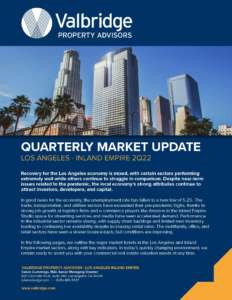Q2 2022 Market Trends Newsletter
August 19, 2022
Recovery for the Los Angeles economy is mixed, with certain sectors performing extremely well while others continue to struggle in comparison. Despite near-term issues related to the pandemic, the local economy’s strong attributes continue to attract investors, developers, and capital.
In good news, the unemployment rate has fallen to a new low of 5.2%. The trade, transportation, and utilities sectors have exceeded their pre-pandemic highs, thanks to strong job growth at logistics firms and e-commerce players like Amazon in the Inland Empire. Studio space for streaming services and media have seen accelerated demand. Performance in the industrial sector remains strong, with supply chain backlogs and limited new inventory leading to continuing low availability despite increasing rental rates. The multifamily, office, and retail sectors have seen a slower bounce-back, but conditions are improving.

Below, we outline the major market trends in four critical Los Angeles and Inland Empire major market sectors, along with key indicators, download the PDF. In today’s quickly changing environment, we remain ready to assist you with your commercial real estate valuation needs at any time.
LOS ANGELES INDUSTRIAL REAL ESTATE TRENDS
- With vacancy rates at 1.9%, the Los Angeles industrial market is among the tightest in the nation. Exceptional demand in 2021 led to a compression in vacancy rates from a recent high of 3.2% in late 2020.
- There is limited space left for tenants to lease in the Los Angeles area, and what space remains is often in obsolete industrial properties that do not meet the needs of many tenants.
- Los Angeles supply growth is is generally limited, given the built-out nature of the L.A. Metro area, a region with some of the highest land values.
- The market saw $9.5 billion worth of property transactions in the past 12 months. 2021 saw the most sales on a dollar basis in the metro area, and 2022 activity year to date has also been robust.
- Average metro asking rents increased by 13.8% during the past 12 months, compared to 11.9% nationally.
INLAND EMPIRE INDUSTRIAL REAL ESTATE TRENDS
- Construction timelines have lengthened due to supply chain backlogs for materials such as steel and roofing. New tenants often to new construction to lease or buy because availability in existing buildings is extremely low. While roughly 75% of the 37.1 million SF currently under construction is available for lease, most deliveries in the past three years have either pre-leased or released shortly after completion.
- The economic recovery has resulted in dynamic rent growth in the industrial sector, with annual gains of 18.8%, compared to 13.4% a year ago.
- Modern logistics facilities with 40-foot clear height and ample dock doors are highly desired. The abundance of land available for development, especially in comparison to neighboring Los Angeles and Orange Counties, makes the Inland Empire a construction hotbed.
LOS ANGELES OFFICE REAL ESTATE TRENDS
- Conditions continue to deteriorate in Los Angeles’ office market.
- While interest rates have held flat since the second half of 2020, concessions and other incentives have been more generous for tenants than those offered prior to the pandemic.
- Market vacancy in Los Angeles currently stands at 13.8%.
- One major concern is the record levels of available sublease space. With just over 10 million SF available as of late June, it remains at record levels. Current levels are 5 million SF above amounts seen at the start of the pandemic.
- With the exception of a handful of submarkets, most notably Burbank, most locations in the metro have seen significant occupancy erosion over the past two years.
INLAND EMPIRE OFFICE REAL ESTATE TRENDS
- The current vacancy rate is 5.9%.
- Rents have grown by 3.3% over the past 12 months and average 3.8% annual growth over the past five years. While rent growth is lower than the five-year average, the Inland Empire has some of the strongest rent gains of any major office marker in the country.
- Rents saw modest losses in 2020, but gains have accelerated since the beginning of last year and rents are up 3.7% from a year ago.
- Sales activity in the Inland Empire’s office market primarily involves local and domestic private buyers, with institutional investors showing limited interest. Investors have picked up the pace during recovery.
LOS ANGELES RETAIL REAL ESTATE TRENDS
- Rent saw modest losses in 2020, but gains have accelerated since the beginning of last year and are up 3.7% from 2021.
- Vacancy has come down slightly to 5.2% after peaking just above 5.5% in 21Q2. Looking ahead, market fundamentals are expected to improve through the rest of the year, with vacancy trending downward as demand outpaces a very modest level of retail completions.
- Average market cap rates, presently 5.3%, are far below the national average of 6.8%.
- Recent sales represent strategies across the risk spectrum, from well-leased, top-tier centers to challenging centers that require reinvention or redevelopment of the property’s site.
INLAND EMPIRE RETAIL REAL ESTATE TRENDS
- The Inland Empire has one of the highest retail vacancy rates in the nation among metros with 1 million or more in population, but that hasn’t adversely impacted rent growth.
- Trailing 12-month sales volume is $2.4 billion, comparing favorably to the five year average of $1.6 billion per year.
- Areas such as Ontario Ranch are approved for thousands of new residential units. Investment has surged as buyers target shopping centers anchored by national credit tenants during the economic recovery.
- Pricing has appreciated as a result, bringing market pricing to a record high of $280/SF and market cap rates to 5.9%.
LOS ANGELES MULTIFAMILY REAL ESTATE TRENDS
- Vacancies have been trending downward (since a peak at the end of 2020) and are currently at 3.4%. Demand has been particularly strong in recent quarters. Gains in the market have been broad-based, as almost every location in the metro has been solid occupancy gains.
- Location ahead, market vacancy is anticipated to continue to decline for the near to mid-term, as tenant demand is forecast to be relatively strong.
- Although average asking rents have been increasing, LA’s average rental rate increase of 6.5% trails the national average of 9.1%. Average asking rents in L.A. presently stand at $2,170/month.
- Average market cap rates of 4.0% are well below the national average of 5.1%.
INLAND EMPIRE MULTIFAMILY HOUSING REAL ESTATE TRENDS
- Asking rents for apartments are up 10.1% over the past 12 months.
- The vacancy rate has fallen to 2.7% from 3.2% in 2020Q3.
- Tenant concessions are rare in the Inland Empire due to elevated demand, even in new properties, which have displayed dynamic leasing velocity in recent quarters.
- The biggest shift in the market has been among high-end properties, which continue to be attractive for families relocating from more expensive California markets.
- The average market cap rate is 4.3%, compared with the five-year average of 4.8%.
- The Inland Empire has long had strong population growth as renters move from more expensive, urban areas. Those trends were accelerated at the beginning of the pandemic, as people left city centers in Southern California and beyond.
For more, including a deep dive article into REITs and other investment vehicles gaining traction as more investors seek entry into the commercial real estate market., DOWNLOAD FULL REPORT HERE.


